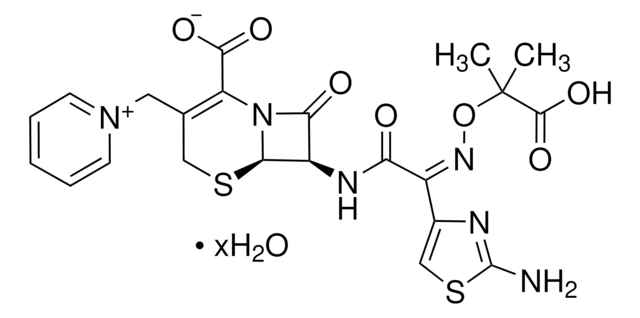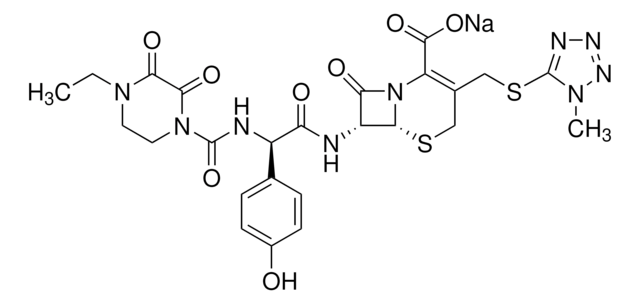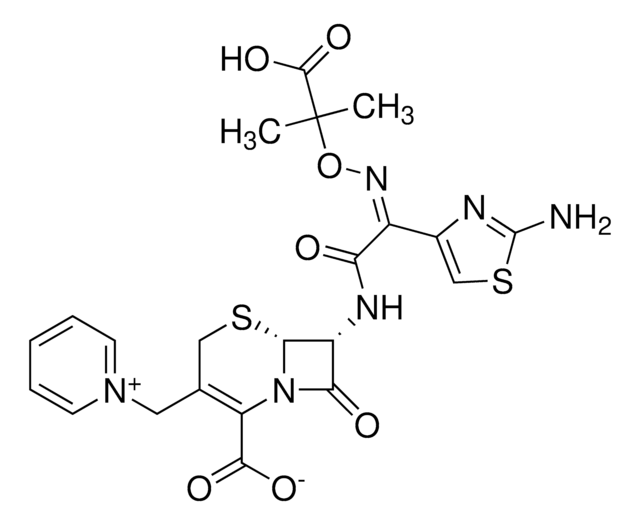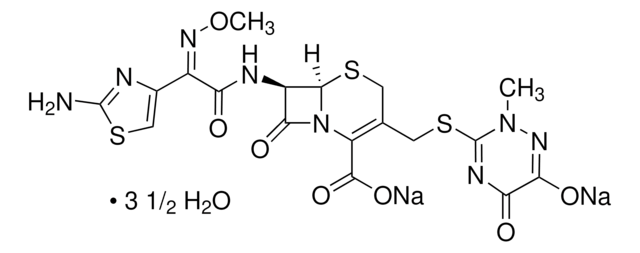Kluczowe dokumenty
About This Item
Polecane produkty
Formularz
powder
Poziom jakości
okres trwałości
limited shelf life, expiry date on the label
rozpuszczalność
H2O: 50 mg/mL
spektrum działania antybiotyku
Gram-negative bacteria
Gram-positive bacteria
Tryb działania
cell wall synthesis | interferes
temp. przechowywania
2-8°C
ciąg SMILES
[Na+].[H][C@]12SCC(CSc3nnnn3C)=C(N1C(=O)[C@]2(NC(=O)CSCC#N)OC)C([O-])=O
InChI
1S/C15H17N7O5S3.Na/c1-21-14(18-19-20-21)30-6-8-5-29-13-15(27-2,17-9(23)7-28-4-3-16)12(26)22(13)10(8)11(24)25;/h13H,4-7H2,1-2H3,(H,17,23)(H,24,25);/q;+1/p-1/t13-,15+;/m1./s1
Klucz InChI
BITQGIOJQWZUPL-PBCQUBLHSA-M
Powiązane kategorie
Opis ogólny
Zastosowanie
Działania biochem./fizjol.
Opakowanie
Inne uwagi
Hasło ostrzegawcze
Danger
Zwroty wskazujące rodzaj zagrożenia
Zwroty wskazujące środki ostrożności
Klasyfikacja zagrożeń
Eye Irrit. 2 - Resp. Sens. 1 - Skin Irrit. 2 - Skin Sens. 1 - STOT SE 3
Organy docelowe
Respiratory system
Kod klasy składowania
11 - Combustible Solids
Klasa zagrożenia wodnego (WGK)
WGK 2
Temperatura zapłonu (°F)
Not applicable
Temperatura zapłonu (°C)
Not applicable
Wybierz jedną z najnowszych wersji:
Certyfikaty analizy (CoA)
Nie widzisz odpowiedniej wersji?
Jeśli potrzebujesz konkretnej wersji, możesz wyszukać konkretny certyfikat według numeru partii lub serii.
Masz już ten produkt?
Dokumenty związane z niedawno zakupionymi produktami zostały zamieszczone w Bibliotece dokumentów.
Nasz zespół naukowców ma doświadczenie we wszystkich obszarach badań, w tym w naukach przyrodniczych, materiałoznawstwie, syntezie chemicznej, chromatografii, analityce i wielu innych dziedzinach.
Skontaktuj się z zespołem ds. pomocy technicznej








